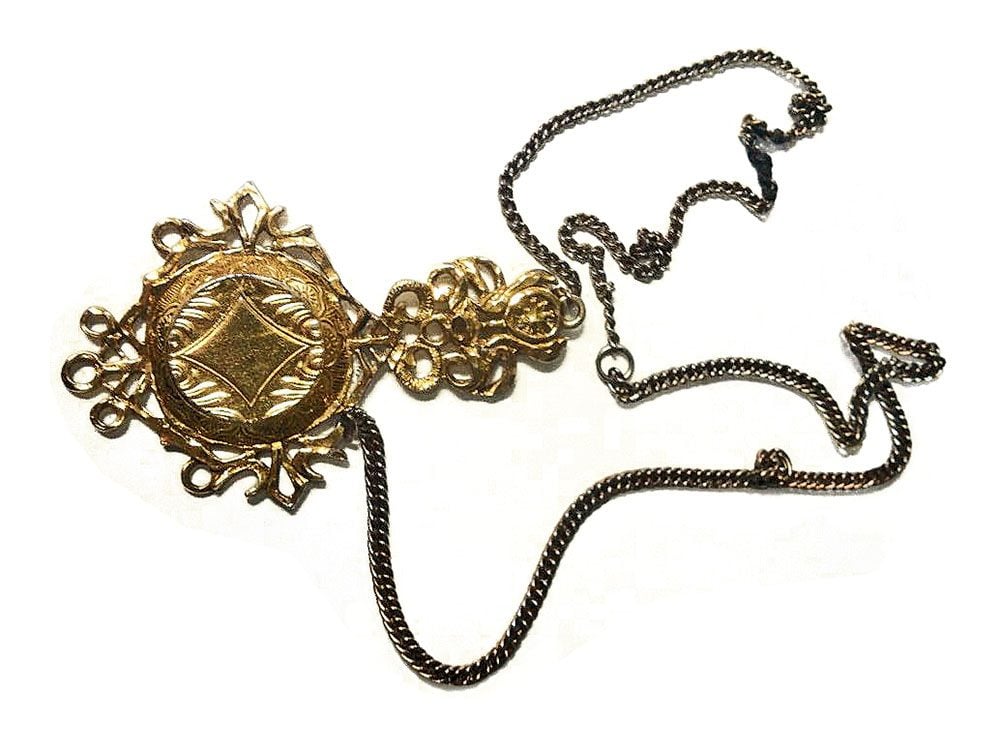
Mystery Object of the Month: What Is It?
Normal Canuel of Vernon, B.C., writes, “My husband Alphonse found this item under our deck, covered in mud and grime. I cleaned it up, but no one can identify it, including the curator at the museum and the local jewellers. Can anyone help us?”
What do you think? Can you help solve this mystery?
Share your answers in the comments below or by sending them in through Our Canada’s submissions site (please identify it as an entry for “What Is It?”).
Challenge yourself to more “What Is It?” mysteries!
Don’t miss out on the best original Canadian photography—sign up for the Our Canada newsletter.

The real reason why Norwegians are the happiest people in the world
Free education and health care are surely among the reasons why the 2017 World Happiness Report declared Norway as the happiest country in the world, but researchers attribute a Norwegian’s good cheer to one single word.
The word is dugnad and it means to do community work. Before you rush out to help an elderly neighbour cross the street or walk dogs at your local shelter (although both are worthwhile activities), you need to know that dugnad does not directly translate to traditional volunteerism, although the work of a dugnad is voluntary.
Deeply rooted in the country’s heritage, dugnad is different than routine charitable work. It describes times when community members come together to contribute their skills toward the goal of maintaining or beautifying a certain geographic location. This could be through repairs, building, cleaning, gardening or painting. Norwegian law doesn’t enforce dugnad event attendance but widespread participation is expected and perceived as a vital part of belonging to neighbourhoods, organizations and workplaces, which all often co-ordinate their own dugnads.
A Norwegian friend tells us, “dugnad is a part of the national soul. It’s not really about patting ourselves on the back for doing a good deed.” Dugnad has a cultural resonance that aligns with Norway’s values for generosity and collective care. Dugnad participation strengthens bonds and maintains a nation; everyone benefits from a well-cared-for community.
If you’re inspired to try it yourself, here are some ideas to bring the spirit of dugnad to your area:
- Create a neighborhood calendar where people can sign up to take turns mowing lawns for the elderly in your area.
- Start a community garden.
- Organize co-workers to repaint the headquarters of a local non-profit.
- Find schools that need books and arrange a donation drive.
- Organize a clean-up day at our local park and plant new flowers.
Remember the goal is to chip in to keep the country happy; instead of hosting a bake sale to raise money to buy a local sports team new uniforms, think of having a sewing party to repair them instead.
No worries if you don’t own any painting supplies or aren’t sure how to garden. Not all of us are the outdoor spring-cleaning type, but you can still contribute by showing up to a charitable community event with water, coffee, or baked goods in hand. Communal food plays big role in the dugnad; a meal after a day of service is customary. A shared meal in the act of helping one another followed by celebratory fellowship can bring us closer to neighbours, co-workers or fellow parents at our child’s school. We’re all about reaping the health benefits of social connection.

The surprising reason we say “hello” on the phone
It’s pure instinct. When our phones ring—after checking caller ID, of course—we pick up and say, “Hello?”
But if Alexander Graham Bell had his way, we would be saying “Ahoy” when using his invention.
The word “ahoy” has been around for at least 100 years longer than “hello.” It came from the Dutch word “hoi,” also a greeting. According to NPR, Bell was so certain it would catch on as the perfect phone conversation starter that he used it for the rest of his life.
Luckily, we don’t have to talk like pirates every time we pick up the phone. You can thank Thomas Edison for that. He was the one who proposed “hello” as the proper greeting, to the chagrin of his rival Bell. At the time, telephones were thought of like modern walkie-talkies, where the line would stay permanently open so businesses could communicate with each other whenever they pleased. The problem was letting the one side know when the other wanted to talk. In a letter to the president of the Central District and Printing Telegraph Company in Pittsburgh, who was about to bring the telephone to that city, Edison suggested saying “Hello!” would be the best way to get someone’s attention.
He was right. “hello” was noted as the official greeting in many of the first phone books. Official manuals of the first telephone exchanges (Ever see movies where switchboard operators connected two callers? That’s a telephone exchange) gave “hello” equal importance.
Of course, what comes after “hello” is what really actually matters. If you can’t think up a memorable conversation starter, Edison would have done all that hard work for nothing.
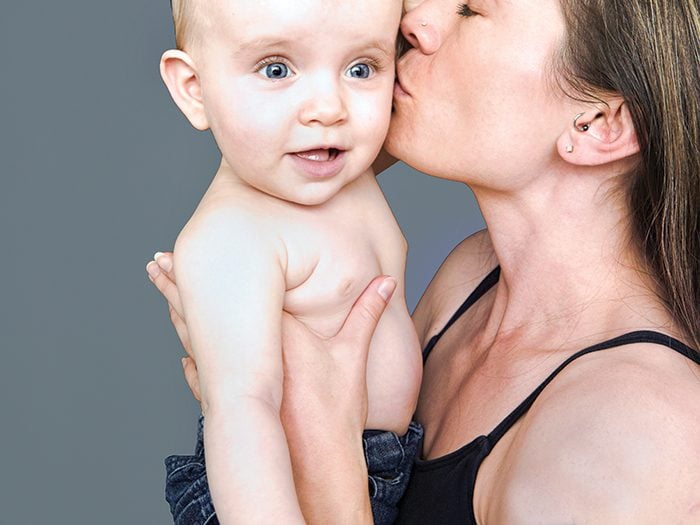
Of our five senses, our sense of touch is the one we are most apt to take for granted, yet it’s the one we can least do without.
“A child can be born blind or deaf and they will grow up just fine, with no cognitive impairments”, as long as they have loving caregivers who hold them often and respond lovingly to their needs, notes US neuroscientist Dr David Linden. The author of Touch: The Science of Hand, Heart and Mind, Linden further notes, “If an infant is deprived of loving social touch for the first two years of life, then all sorts of disasters unfold.”
Adults, too, benefit hugely from regular social, non-sexual touch and caresses.
Health Benefits The pluses for adults are many: Positive touch can reduce stress hormones, improve blood pressure, mood and our immune systems–among other benefits.
Therapeutic massage and other touch therapies are also beneficial to premature infants or newborns, people undergoing cancer therapy, elderly individuals in nursing homes and athletes trying to maximize performance levels.
Neuroscientist Linden says, however you do it, “maximizing touch in your life is a good thing “—whether it is a massage, holding hands, petting a dog, going to the hairdresser, hugging our kids, our partners or even a stranger.
New Research On Human Touch It is only in recent years that science has begun to understand the complex system of nerves, sensors and receptors that link our skin and brain to our environment and the other people in it.
We have nerve sensors to detect texture, another for vibration, yet another for pressure, another for itch. And most importantly, “We have special nerve fibres purely to detect caresses by other people,” notes Dr Håkan Olausson, professor of clinical neuroscience at Linkoping University in Sweden.
When our touch fibres don’t work properly, it may undermine making emotional connections to others. New research shows some children with autism may have a difference in their touch sensors that prevents them from feeling comfort from another person’s soft touch.
“When we put our hands on each other,” says Dr Linden, “we are tapping into deep associations between touch and emotion that were kindled at the dawn of life.”
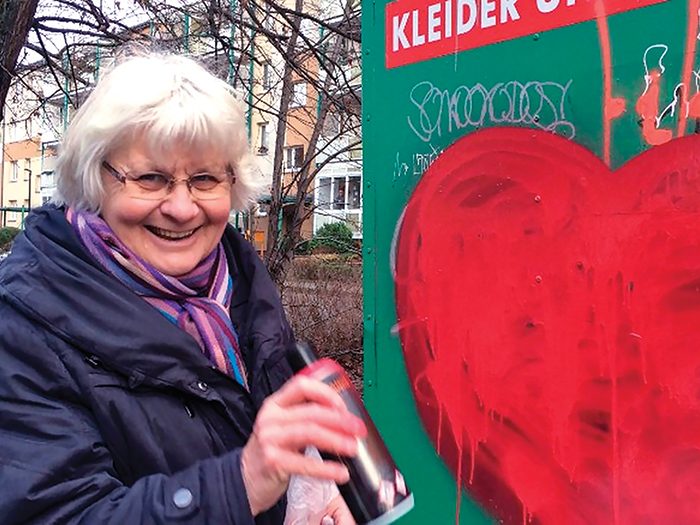
Scrubbing out hate
Society Visiting cities all over Germany, 71-year-old Berliner Irmela Mensah-Schramm (pictured) spends several days a week searching for banned Nazi symbols and anti-immigration slogans, which she then erases. In her bag, she carries red paint, nail polish remover and a scraper. If she sees a painted swastika, she turns it into a red heart instead.
Her mission started 31 years ago, when she was shocked to discover a sticker at her local bus stop calling for the release of Nazi war criminal Rudolf Hess. Finding it still there on her way home, she scraped it off with her keychain. Over the next three decades, she continued to take action against neo-Nazi propaganda, removing more than 130,000 offensive signs and stickers.
Her work is not without risks: she’s been assaulted a few times and last year was threatened with a €1,800 fine for defacing public property.
But she is unrepentant. “I’m really concerned by this hate propaganda. And I want to take a stand,” she says. “Freedom of speech has limits. It ends where hatred and contempt for humanity begin.”
Batteries: A nuclear approach
Science A team of scientists at Bristol University in the UK have come up with an idea that could solve some of the problems of nuclear waste, clean electricity generation and battery life. It involves combining a man-made diamond with a radioactive field, which then generates a small electrical current.
“We can turn a long-term problem of nuclear waste into a nuclear-powered battery and a long-term supply of clean energy,” says Professor Tom Scott.
The plan is to utilize the technique with carbon-14 from graphite blocks used in nuclear-power plants. It will reduce their radioactivity, lessening the challenge of storing them safely, while the carbon-14 extracted can be incorporated into a diamond to produce a nuclear-powered battery that will take more than 5,000 years to lose even half its power.
Swedes encouraged to repair
Tax Since the beginning of the year, Swedish consumers have benefited from tax breaks on repairs to everything from bicycles to washing machines. The move is the brainchild of government minister Per Bolund. “There is a shift in view in Sweden at the moment,” he explains. “There is an increased awareness that we need to make our things last longer in order to reduce materials’ consumption.”
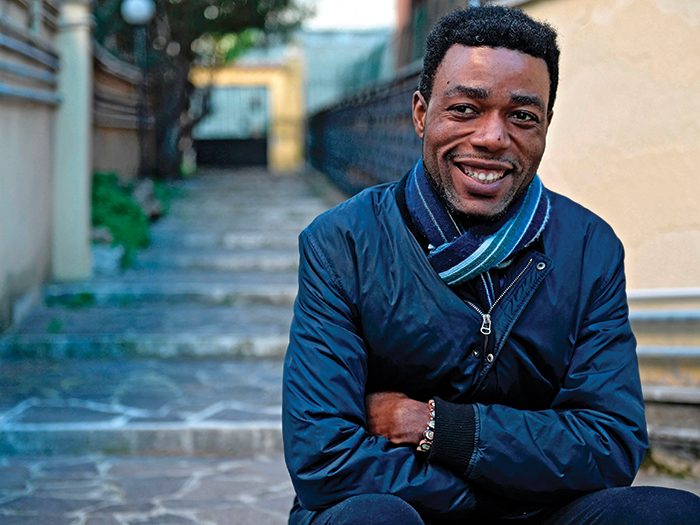
Exposing wage slavery
Heroes As a Cameroonian studying in Italy, Pierre Yvan Sagnet needed to make some money. A friend suggested tomato-picking—and this was how he came to experience the notorious “caporalato” system under which farm owners exploit seasonal workers. Workers would put in 16-hour days for wages of 20-25 per day, from which the price of water and sandwiches would be deducted. Sagnet was outraged and organized a strike among fellow workers, which resulted in better pay and conditions—and a new law criminalising the practice. “Here, in the heart of Europe, I have seen human beings stripped of every last scrap of dignity,” he recalls of his time in Nardo, in the heel of Italy. In recognition of his work, the 31-year-old has now been named a Knight of Italy’s Order of Merit.
Sources: Society: The Independent, 19.12.2016. Science: Good News Network, 6.12.2016. Tax: The Guardian, 19.9.2016. Heroes: BBC News, 4.1.2017

15 Minutes with Amybeth McNulty
Reader’s Digest Canada: You’re Anne Shirley in the new Anne of Green Gables miniseries. Nearly 2,000 actors tried out for the role. Any idea how you clinched it?
Amybeth McNulty: I didn’t realize what a big deal it was until just before I came to Toronto from Ireland for the final audition! I haven’t experienced the trauma that Anne did, but I’ve been told we have similarities. We share a love of the world—of God, humans and nature. We merged really well, so it wasn’t just acting for me.
With the books and the 1985 CBC series, there’s lots of material to draw on. How did you prepare?
I didn’t watch or read any versions of the story, other than our script, because I didn’t want to be affected by them.
Anne has a real knack for landing in sticky situations. Do you share that quality?
Of course, I have my ways of getting into trouble. We all have times when we think, Oh my God, can the world please swallow me up and take me away from this? Everybody can relate to that—it’s why Anne is so popular.
She especially appeals to young girls. Why do you believe that is?
It’s the idea of Anne thinking that girls were no different from boys, her power and her struggles. She had a lot of challenges—feeling not good enough or not pretty, trying to get a boy to like her, growing annoyed by people—and her willpower makes you wish you were like her.
Anne famously had a love-hate relationship with her carrot top. How do you feel about your own mane?
I really like red hair. I think if you have brown hair, you want blond hair; if you have blond hair, you want blue hair. We always want what we don’t have. It takes a while to admit, Hey, it’s just part of me.
And how do you feel about puffed sleeves?
Oh, I love them. I love my Anne dresses, but when I see the other girls with their puffed-sleeve costumes, I know how she feels—that sense of longing.
Has it weighed on you playing a character who’s so beloved?
I try to let it go. I’m not going to compare myself to Megan Follows [who played Anne in the 1985 series]. Other people will, and that’s fine—she’s the Anne—but my Anne is different and beautiful and unique.
Head writer Moira Walley-Beckett has described the new Anne as grittier than previous versions. How so?
It’s more realistic, with flashbacks showing the abuse Anne has gone through. There are more layers.
Walley-Beckett won an Emmy for Breaking Bad, which is certainly gritty. Have you seen it?
My grandmother and I recently watched it on Netflix. I loved it. My grandmother did too—she went on a Netflix marathon for the first time.
Your mother was born in Calgary, but you’re from Ireland. What’s been your favourite discovery since you started filming here?
Maple syrup. It’s basic, but so good.
And what’s one thing you miss about home?
Your Dairy Milk chocolate tastes different. I think it must be the milk. My friend brought over some Irish chocolate and I was extremely happy.
Anne airs on CBC until May 7.
We’re counting down the 10 Strongest Female Literary Characters of All Time!
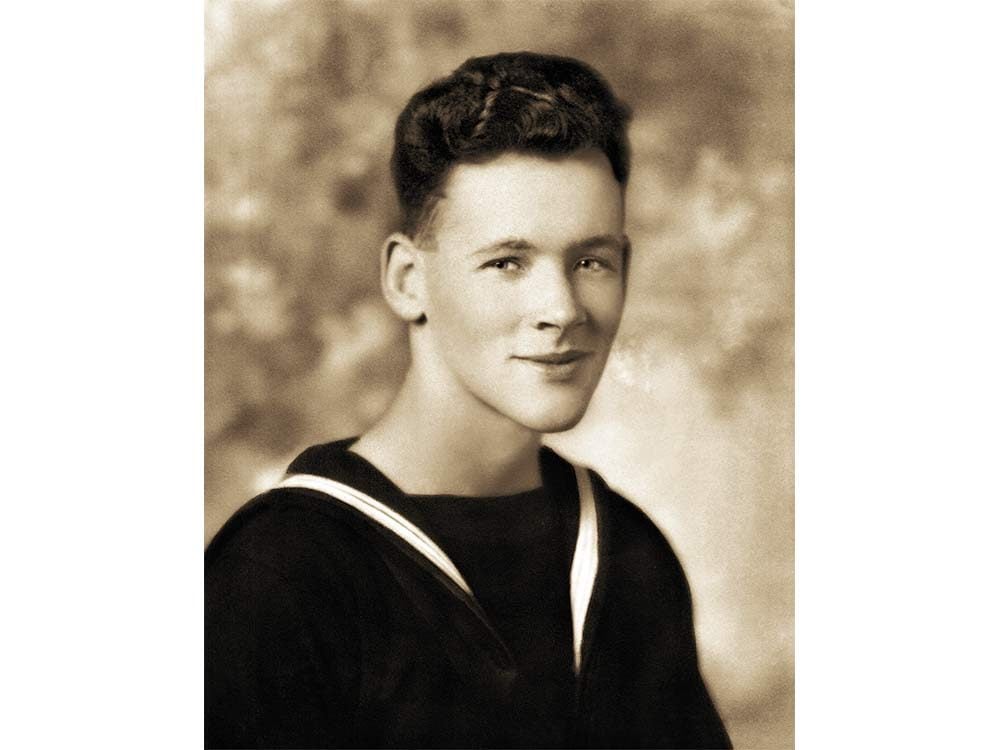
Veteran Profile: Ronald Lewis Rhine
Born in Calgary on July 26, 1925, Ronald joined the Calgary Highlanders when he was 16, but was not allowed to continue because of his young age. When he turned 18 in 1943, he joined the Royal Canadian Navy and saw Atlantic convoy duty on the frigate HMCS Eastview. He was later posted to Motor Torpedo Boat 748, where he saw close action against German convoys, destroyers and Schnellboots in the North Sea. He currently resides in Kelowna, B.C.
“We never went out in the daytime because if any airplane, including our guys, saw a water contrail they would swing down and attack…”
For more profiles by Veterans Voices of Canada, click here.